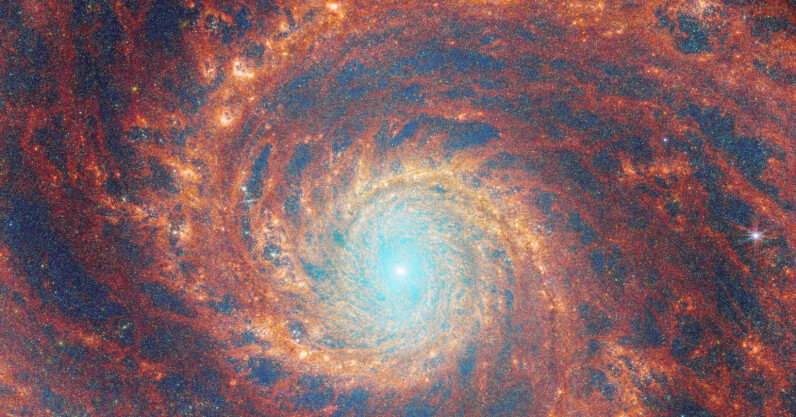First discovered in 1773 by French astronomer Charles Messier, the Whirlpool galaxy (aka ‘M51’) is one of the most well-known objects in the night sky. Everyone from amateur astronomers to NASA have been sharing images of the Whirlpool galaxy for decades.
But never have you seen an image like the one just captured by the James Webb Space Telescope, the most powerful of its kind.
What exactly am I looking at here?
This mesmerising picture (featured top) is a composite image from the telescope’s NIRCam and MIRI instruments. Both devices are built to capture the distant universe by decoding infrared light signals emanating from faraway stars and galaxies. The end result is the Whirlpool galaxy in never-seen-before detail.
The dark red regions trace the filamentary warm dust permeating the medium of the galaxy. The red regions show the reprocessed light from complex molecules forming on dust grains, while colours of orange and yellow reveal the regions of ionised gas by the recently formed star clusters.

The <3 of EU tech
The latest rumblings from the EU tech scene, a story from our wise ol’ founder Boris, and some questionable AI art. It’s free, every week, in your inbox. Sign up now!
“Stellar feedback has a dramatic effect on the medium of the galaxy and creates complex network of bright knots as well as cavernous black bubbles,” said the European Space Agency, which helped build the telescope and launched it into space last year from its spaceport in French Guiana.
Stellar feedback is the term used to describe the outpouring of energy from stars into the environments that form them and is a crucial process in determining the rates at which stars form. Understanding stellar feedback is vital to building accurate universal models of star formation, said the agency.
The James Webb image is one of a series of observations intended to shed light on the interplay between stellar feedback and star formation in environments outside of our own galaxy, the Milky Way.

M51 is nicknamed the Whirlpool because of its swirling structure, which resembles water circling a drain. It lies some 30 million light-years away in the constellation Canes Venatici, which means the image we see shows how the Whirlpool galaxy looked 30 million years ago.
The Whirlpool has a little brother — the dwarf galaxy NGC 5195. The gravitational influence of M51’s smaller companion is thought to be partially responsible for the distinct nature of the galaxy’s prominent, well-developed spiral arms.
When released in 2011, Hubble’s images of the Whirlpool galaxy stunned the world. However, in a prophetic twist, the team behind the images said “although Hubble is providing incisive views of the internal structure of galaxies such as M51, the planned James Webb Space Telescope is expected to produce even crisper images.”
If you want to understand how the Whirlpool galaxy works and why it is so special, check out this video featuring Michael Merrifield, Professor of astronomy at the University of Nottingham:
